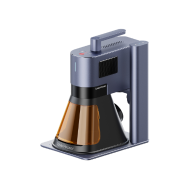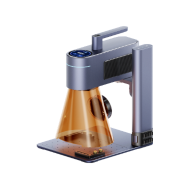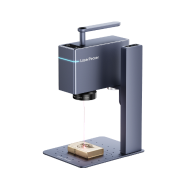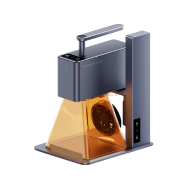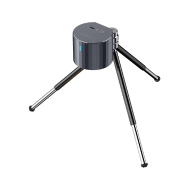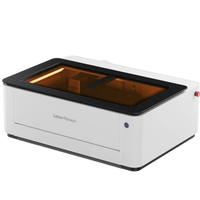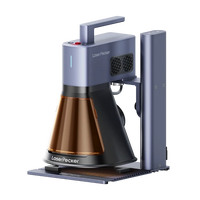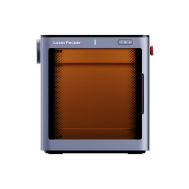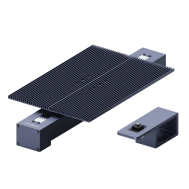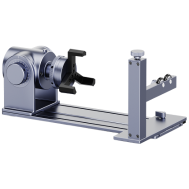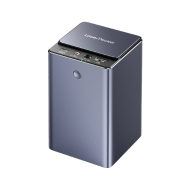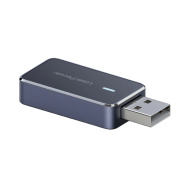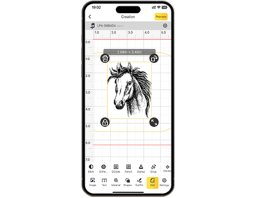Engraving metal is an art that melds craftsmanship with precision. From personalized jewelry to industrial applications, mastering this technique opens a world of creative possibilities.
In this comprehensive guide, we will introduce how to engrave metal. Whether you're a novice seeking to explore a new skill or a seasoned artisan looking to refine techniques, our step-by-step instructions, tips, and insights will illuminate the intricate process of engraving metal.

In this article:
Method 1: Laser Engraving Metal
Tools Needed for Laser Engraving Metal
- Laser Engraving Machine: Specifically designed for metal laser engraving.
- Computer Design Software: To create or import designs for engraving.
- Metal Workpiece: Suitable metal material compatible with laser engraving.
- Safety Gear: Laser safety glasses to protect eyes from the laser beam.
- Masking Material: Used to protect areas of the metal surface from the laser engraving process.
- Ventilation System: Ensures proper ventilation and removal of fumes or debris generated during engraving.
How to Laser Engrave Metal?
- Design Preparation: Create or import the design into software compatible with the laser engraving machine.
- Workpiece Setup: Securely place the metal workpiece within the laser engraving machine.
- Calibration: Calibrate the laser settings (power, speed, frequency) based on the metal type and desired engraving depth.
- Masking Application: Apply masking material to areas you don't want to engrave to protect them from the laser beam.
- Start Engraving: Initiate the engraving process through the software. The laser will follow the specified design, removing material and creating the engraved pattern.
- Post-Processing: Once engraving is complete, remove the masking material and clean the engraved surface to remove any debris or residue.
Tips for Laser Engraving Metal
- Material Compatibility: Ensure the metal being used is suitable for laser engraving and won't emit harmful fumes.
- Masking Consideration: Apply masking precisely to protect areas not intended for engraving.
- Test Engraving: Conduct test runs on a similar metal piece to fine-tune settings and verify the design before engraving the final piece.
- Safety Measures: Always wear appropriate laser safety glasses and follow safety protocols when operating the laser engraving machine.
- Maintenance: Regularly clean the laser engraving machine's lenses and components for optimal performance.
Method 2: Hand Engraving Metal (Carving)
Tools Needed for Hand Engraving Metal
- Engraving tool (graver): Various shapes and sizes are available for different effects.
- Metal vice: To securely hold the metal piece during engraving.
- Magnifying glasses: Aid in precision for detailed work.
- Layout tools: Rulers, markers, and scribes for transferring designs onto the metal.
- Safety gear: Safety glasses to protect eyes from metal shavings.
How to Engrave Metal by Hand?
- Prepare the Metal: Secure it in the vice and clean the surface thoroughly.
- Design Transfer: Transfer your chosen design onto the metal using a scribe or marker.
- Hold and Use the Engraving Tool: Grip the graver like a pencil. Begin with light strokes, gradually increasing pressure as needed. Experiment with different graver shapes and sizes for varied effects.
- Practice Control: Achieve consistency and precision in your strokes. Experiment with line weights and textures by adjusting pressure and stroke techniques.
- Finish and Clean: After engraving, clean the metal surface to remove debris and polish it for enhanced visibility.
Tips for Hand Engraving Metal
- Start Simple: Begin with basic designs before progressing to more complex ones.
- Patience and Practice: Engraving takes time and practice to master. Be patient and keep practicing to improve your skills.
- Experiment: Try different graver shapes, stroke techniques, and depths to create unique effects.
- Safety First: Always wear safety glasses to protect your eyes from metal shavings.
Method 3: Rotary Engraving Metal (Dremel)
Tools Needed for Rotary Engraving Metal
- Rotary tool (e.g., Dremel): Choose appropriate bits for engraving metal.
- Metal vice or clamp: To secure the metal piece during engraving.
- Safety gear: Safety glasses and a dust mask for protection.
- Engraving bits: Carbide or diamond-tipped bits for metal engraving.
- Cleaning supplies: Cloth for wiping debris and a brush to clean metal shavings.
How to Engrave Metal with A Dremel?
- Prepare the Metal: Secure it in a vice or clamp, ensuring it's stable.
- Select the Engraving Bit: Choose the appropriate engraving bit for metal and insert it into the rotary tool.
- Mark Your Design: Transfer your design onto the metal surface using a marker or scribe.
- Engraving Process: Hold the Dremel like a pencil and start engraving, using a consistent speed and light pressure. Follow your marked design, adjusting pressure for different line depths.
- Control and Precision: Practice controlling the Dremel to achieve the desired depth and style in your engraving. Maintain a steady hand for clean lines.
- Clean the Engraved Area: Use a brush and cloth to remove metal shavings and debris from the engraved area.
Tips for Rotary Engraving Metal
- Bit Selection: Use the right engraving bits for metal to achieve clean and precise lines.
- Practice on Scrap Metal: Before engraving your final piece, practice on scrap metal to get comfortable with the tool and technique.
- Safety Measures: Wear safety glasses and a dust mask to protect against metal shavings and dust.
- Consistency in Speed and Pressure: Maintain consistent speed and pressure for even and controlled engraving.
- Experiment and Refine: Experiment with different bit shapes and depths to create varied textures and effects.
Method 4: Cricut Engraving Metal
Tools Needed for Cricut Engraving Metal
- Cricut Maker: Specifically equipped with the engraving tip.
- Metal Engraving Sheets: Thin metal sheets compatible with Cricut engraving.
- StrongGrip Mat: To hold the metal sheet firmly in place during engraving.
- Engraving Tip: Specifically designed for the Cricut Maker machine.
- Design Software: Software compatible with Cricut to create or import designs.
- Cleaning Supplies: Cloth for removing debris after engraving.
How to Engrave Metal with Cricut Maker?
- Prepare the Design: Create or import your design using Cricut Design Space software. Ensure the design fits within the dimensions of the metal sheet.
- Secure Metal Sheet: Place the metal sheet onto the StrongGrip Mat and ensure it's firmly attached to prevent movement during engraving.
- Install Engraving Tip: Insert the engraving tip into the Cricut Maker machine, following the manufacturer's instructions.
- Load Design and Engrave: Follow the prompts on Cricut Design Space to select the engraving design and settings. Load the mat into the machine and begin the engraving process. The Cricut Maker will engrave the design onto the metal sheet automatically.
- Remove and Clean: Once the engraving is complete, carefully remove the metal sheet from the mat. Use a cloth to clean off any debris or residue from the engraved area.
Tips for Cricut Engraving Metal
- Choose Suitable Metal: Ensure the metal sheets used are compatible with the Cricut engraving process.
- Design Considerations: Opt for designs that suit the capabilities of the engraving tip to achieve clear and defined engravings.
- Secure Placement: Double-check that the metal sheet is securely attached to the StrongGrip Mat to prevent shifting during engraving.
- Test on Scrap Metal: Before engraving your final design, consider testing on a small piece of the same metal to ensure settings and design work as intended.
- Regular Maintenance: Clean the machine and the engraving tip regularly for optimal performance and longevity.
Method 5: CNC Engraving Metal
Tools Needed for CNC Engraving Metal:
- CNC Machine: Specifically equipped for metal engraving.
- Computer with CAD/CAM Software: To design and generate toolpaths for engraving.
- Metal Workpiece: Suitable metal material for CNC engraving.
- Engraving Bits: Carbide or diamond-tipped bits designed for metal engraving.
- Tool Holders and Collets: To securely hold the engraving bits.
- Coolant or Lubricant: For cooling and lubricating during the engraving process.
- Safety Gear: Safety glasses and ear protection.
How to Engrave Metal with CNC Machine?
- Design Preparation: Create or import the design into CAD/CAM software. Generate toolpaths specifying the depth, speed, and tool changes required for engraving.
- Workpiece Setup: Securely clamp the metal workpiece onto the CNC machine bed to prevent movement during engraving.
- Tool Selection and Installation: Choose the appropriate engraving bit and install it into the CNC machine's spindle using the proper collet or tool holder.
- Set CNC Parameters: Input the necessary parameters (speed, depth, feed rate) into the CNC machine based on the material and design specifications.
- Run the Engraving Program: Start the CNC machine and execute the engraving program. Monitor the process to ensure accuracy and make any necessary adjustments.
- Clean and Inspect: After engraving, remove the metal workpiece from the CNC machine. Clean off any debris or coolant/lubricant residue from the engraved area.
Tips for CNC Engraving Metal
- Proper Fixture: Ensure the metal workpiece is securely fixed to prevent movement during engraving, which could affect precision.
- Toolpath Optimization: Optimize toolpaths in the CAD/CAM software for efficient and accurate engraving.
- Coolant/Lubrication Control: Maintain proper coolant/lubrication to prevent overheating and prolong tool life.
- Tool Inspection: Regularly inspect engraving bits for wear and tear. Replace them when necessary to maintain quality engravings.
- Test on Scrap: Before engraving the final piece, consider testing on a scrap metal piece to fine-tune settings and verify the design.
FAQs About Engraving Metal
Q1. What types of metals can be engraved?
Various metals can be engraved, including stainless steel, aluminum, brass, copper, silver, gold, and more. However, the hardness and composition of the metal can affect the engraving process and results.
Q2. What engraving methods are suitable for different metal types?
Hand engraving, rotary engraving, CNC engraving, and laser engraving are all viable methods for engraving different types of metals. The choice often depends on the desired precision, complexity, and surface hardness of the metal.
Q3. Is it possible to engrave on coated or plated metals?
Engraving on coated or plated metals is feasible, but it's essential to consider the thickness and composition of the coating. Engraving might affect the coating's integrity, potentially revealing the underlying metal.
Q4. Can detailed designs or photographs be engraved on metal?
Yes, detailed designs, logos, text, and even photographs can be engraved on metal using high-precision engraving methods like CNC or laser engraving. These methods offer the ability to create intricate and complex designs.
Q5. How deep can metal be engraved?
The depth of metal engraving varies based on the engraving method, the type of metal, and the intended purpose. Hand engraving typically creates shallower engravings, while CNC or laser engraving can achieve deeper and more precise cuts.
Q6. Can I engrave on curved or irregularly shaped metal surfaces?
Engraving on curved or irregular surfaces can be challenging but is possible using specialized equipment like rotary engraving machines or laser engravers with rotating fixtures designed to accommodate such surfaces.
Q7. Are there limitations to the size of the metal that can be engraved?
Engraving machines have specific workable areas, and the size of the metal that can be engraved depends on the machine's capabilities. However, larger pieces may require specialized machinery or multiple setups for complete engraving.
Q8. How durable are metal engravings?
Metal engravings, especially those achieved through methods like CNC or laser engraving, tend to be highly durable. The depth and technique used can impact the longevity of the engraving, making deeper engravings more resistant to wear and fading.
Q9. Can I engrave metal at home?
Yes, depending on the method chosen, some metal engraving techniques can be performed at home with the appropriate tools and equipment. However, certain methods like CNC engraving might require professional-grade machinery.
Q10. Is there a difference between engraving and etching on metal?
Engraving typically involves physically cutting or removing material from the metal surface to create a design or text. Etching, on the other hand, often involves chemical or laser processes to create designs by altering the metal's surface without removing material.
Conclusion
In conclusion, engraving metal is a versatile art that offers multiple methods to create intricate designs, texts, and patterns on various types of metals. Whether employing traditional hand engraving for artistic finesse, using rotary or CNC machines for precision, or opting for laser engraving for intricate detailing, each method presents unique benefits and applications.
The durability and versatility of metal engravings make them ideal for personalized items, industrial labeling, artistic expressions, and more. Understanding the tools, techniques, and limitations of each method can help achieve professional and lasting results in metal engraving for a wide range of purposes.
